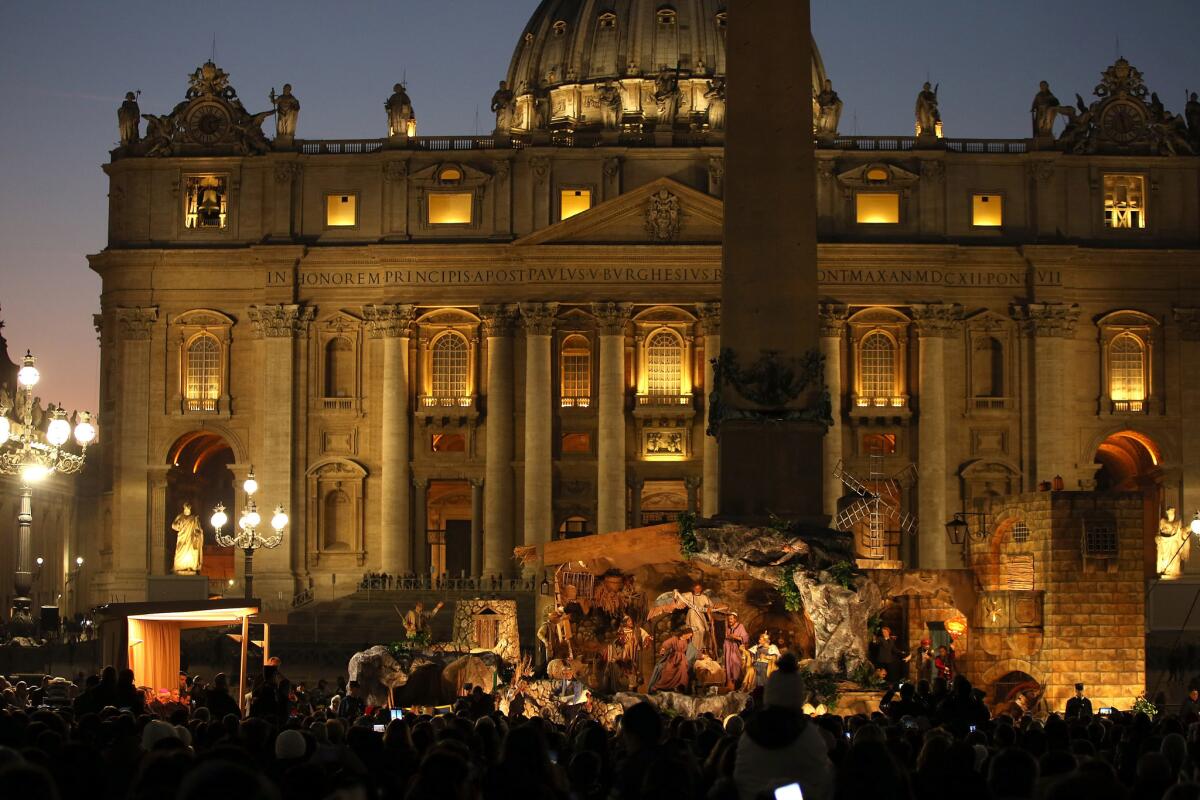On the Ground: The Vatican’s Nativity scene is a reminder that refugees’ struggles are like those of baby Jesus, the pope says

- Share via
Reporting from Vatican City — The life-sized figures of Mary and Joseph were to be expected. What drew the longest gaze from visitors to the Nativity scene on St. Peter’s Square this Christmas was the strange pile of crushed masonry in front of the stable.
The shattered stonework came from the cathedral in the central Italian town of Norcia and was retrieved after an earthquake struck Oct. 30 and wrecked the church.
A metal cross toppled from the peak of the cathedral that day. Placed next to the stones, it is a reminder not only of Norcia’s fate, but also of the many tremors that shook central Italy this year and claimed hundreds of lives.
When the church in Norcia is rebuilt, the cross will be placed back on the roof.
“The cross is a beautiful addition to the Nativity scene since it reminds us that we must never forget what happened in the mountains this year,” said Franco Montuschi, 69, a Roman who was visiting the scene.
If the display summed up a year of shocks, it also reflected Pope Francis’ talent for serving up strong symbols of the world’s troubles.
This Nativity was a twist on the usual tableau of the birth of Jesus. Designed by an artist from Malta and depicting village life on the Mediterranean island, it included fishermen and a typical Maltese fishing boat.
Inaugurating the scene this month, Francis said the boat was a reminder of the migrants who have risked their lives sailing across the Mediterranean to Europe from north Africa this year.
While more than 175,000 people made it across by December, 5,000 or so others died trying. It was the deadliest year for migrant crossings.
“The painful experience of these brothers and sisters reminds us of that baby Jesus, who could not find shelter, was born in a stable in Bethlehem and was later brought to Egypt to escape Herod’s threat,” the pope said.
Around the edge of the square, homeless people drawn to the Vatican by Francis’ offer of free haircuts and hot showers curled up against the cold in cardboard boxes. Tourists heading for the Nativity scene stepped gingerly around them.
Beside the Nativity stood an 82-foot fir tree felled in the Italian Dolomites, lifted onto a truck by an Italian army Chinook helicopter and driven into St. Peter’s Square one night.
The tradition of the tree alongside the Nativity scene in St. Peter’s dates to 1982, when Polish Pope John Paul II introduced them.
It is no surprise that it took a northern European pope to install a Christmas tree, which is not customary in the Mediterranean. What is curious, however, is that John Paul’s Italian predecessors had never set up a Nativity scene, since Italy goes crazy for them at Christmastime.
To understand that passion, a detour inside the Vatican’s walls is needed, beyond the Swiss guards at the gate, around the imposing marble rear of St. Peter’s Basilica and past the gasoline pump outside Francis’ residence.
Beyond that, close to the Vatican’s police station but before the department store, stands another Nativity scene, created by the Vatican gardeners — the first of many dotted around the gardens of the tiny city state.
Farther on, toward the retirement cottage of the former pope, Benedict, stands the headquarters of the Vatican’s governorate, which has a staff of 1,911. In the foyer sits an elaborate and enormous Nativity under a glass case.
“I have seen about a dozen large Nativity scenes set up by the various departments here at the Vatican,” said Giuseppe Puglisi-Alibrandi, the governorate lawyer who helped oversee the construction of the scene in St. Peter’s Square.
“Here at the governorate for example, the head of the purchasing department has two Nativity scenes in his office,” he said. “But then again, he is from near Naples.”
For centuries, artists from the southern city have been turning out intricately sculpted Nativity figures that are prized by collectors.
From a window of the governorate, Puglisi-Alibrandi pointed at a fir tree in the rolling gardens. “That was the first tree that went up in St. Peter’s in 1982,” he said. “It was replanted here after Christmas.”
These days, trees come from forests scheduled to be thinned out to protect against fire or disease, he said. “They are trees that are due to be cut down anyway,” he said. After Christmas, the trunks are given to charities to be turned into furniture or toys, and the branches are turned to sawdust and used as fertilizer in the Vatican gardens.
Kington is a special correspondent.
ALSO
Powerful typhoon slams into Philippines
Op-Ed: What Christmas was like in downtown L.A. in 1954
More to Read
Sign up for Essential California
The most important California stories and recommendations in your inbox every morning.
You may occasionally receive promotional content from the Los Angeles Times.










